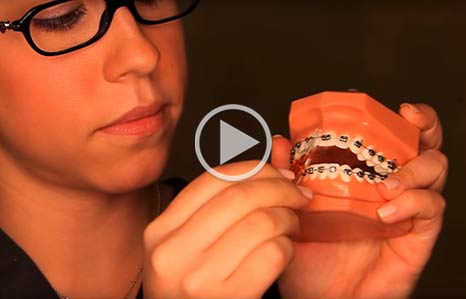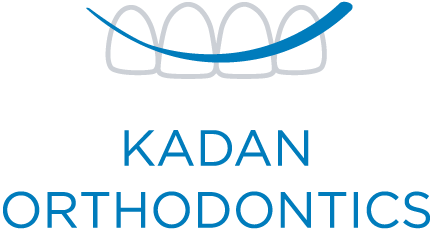Flossing and brushing with braces is possible, but you will need to learn some new techniques to maintain good oral hygiene. Your braces create new places where food particles, bacteria, and plaque will accumulate. Without proper brushing and flossing, you may develop tooth decay, gum disease and even possibly loose teeth. In order to keep your teeth and gums healthy, you need to be vigilant with your oral hygiene. View the video below for an overview, then keep reading!

Brushing with Braces
Dr. Kadan will recommend a toothpaste and toothbrush for brushing with braces. In most cases, he will recommend a soft toothbrush and fluoride toothpaste, but you should confirm this with him during your appointment. He will also instruct you on the technique to use and how often to brush your teeth. Most patients need to brush their teeth four times each day: after eating breakfast, lunch and dinner, as well as right before going to bed.
Proper Brushing Techniques During Treatment
- Use the toothbrush at an angle. Apply a gentle pressure while moving the toothbrush in a small circular pattern paying special attention to the gum line where food particles are most likely to be trapped.
- Brush each tooth and section of gums and braces for two minutes, and make sure that you cover the entire area of your mouth, both on the front and back side.
- Once you cover the front and back of the teeth, take some time to brush the bottom teeth in a downward motion and the top teeth in an upward motion.
- Brush your cheeks, tongue, and roof of the mouth.
- Rinse your mouth several times.
You should replace your toothbrush after each orthodontic appointment. By timing the replacement with your appointment, you are more likely to remember. Replacing your toothbrush ensures that the bristles are in good shape, and that hard-to-reach areas are properly cleaned. Follow your brushing with flossing, rinsing with antibacterial mouthwash and a fluoride treatment.
Flossing with Braces
Flossing removes any remaining food particles and bacteria that cannot be reached with even the best brushing techniques. You will need to floss each day in the morning and before bed. You can floss more frequently, but not less frequently. Trapped particles and bacteria can work very quickly to erode teeth and gums, especially while wearing braces.
The easiest way to floss your teeth with braces is to use a disposable floss threader. The floss threader allows you to reach the area under the archwire.
- Place a small amount of floss on the threader.
- Slide the floss between the teeth and use an up-and-down motion. If possible move the floss from the side of one tooth to the side of the neighboring tooth.
- When you hear a slight “squeak,” you can move to the next tooth.
- Use a gentle pressure when you are flossing around the archwire.
If you are unable to use a floss threader, you can use standard floss by wrapping a piece around your middle two fingers. Carefully guide the floss between your teeth and use the same motion that is described for the threader. As you move to another tooth, wrap the floss around one of your fingers so that you use a fresh section of floss each time.
Your gums may bleed slightly when you first floss with braces. Continue to floss for a few days and the bleeding should subside. If the bleeding continues or worsens, contact our office to schedule an appointment. Dr. Kadan will determine the cause of the bleeding and advise you about steps to take








